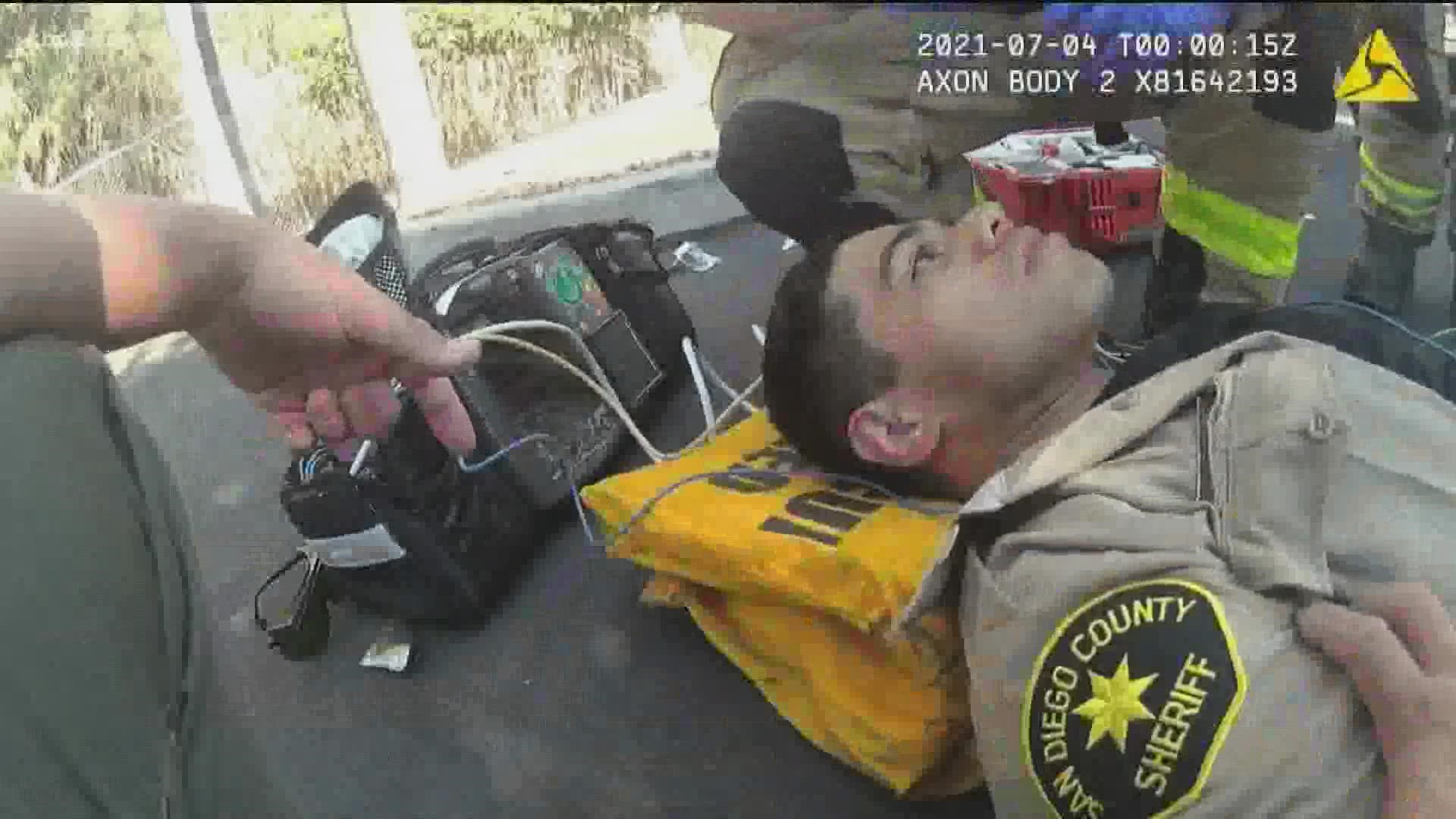SAN DIEGO COUNTY, Calif. — The San Diego County Sheriff's Department on Thursday released body camera footage related to an alleged fentanyl overdose of a deputy that was met with skepticism after it was posted on social media last week.
The department also claimed the deputy who "overdosed" was not given a toxicology screening at the hospital he was taken to after the incident.
The new video includes two clips - nearly an hour-long each - and features body camera footage from deputies David Faiivae and Scott Crane.
Last week, the department released what they have called a PSA and said Faiivae suffered a "fentanyl overdose" during a July 3 call and asserted that his life had been saved by Crane who administered Narcan doses.
The original video which was presented as a way to warn the public on the dangers of the synthetic opioid fentanyl was met with controversy as medical professionals countered that touching or inhaling fentanyl would not cause the reaction seen in the video.
The new footage can be viewed at the links below but may be disturbing to some viewers and includes adult language:
In releasing the video Thursday, the department wrote in part:
"In response to numerous requests regarding an incident in San Marcos on July 3, 2021, here's footage from the body-worn cameras of Deputies David Faiivae and Scott Crane. The video shows Deputy Faiivae processing a white powdery substance that tested positive for Fentanyl and Fluorofentanyl.
There have also been questions about a toxicology test. The hospital did not take a sample from Deputy Faiivae as part of his treatment."
San Diego County Sheriff Bill Gore said earlier this week in an interview with the San Diego Union-Tribune that no blood test had confirmed an overdose. “Gore said he, not a doctor, concluded that Deputy David Faiivae suffered an overdose from incidental contact with fentanyl in the July 3 incident featured in the video,” the newspaper reported.
Medical professionals and viewers online have questioned the veracity of Gore's claim that Faiivae suffered an overdose and asserted that it could have been a panic attack brought on thinking the drugs he was handling were dangerous to touch.
“I’m sorry, my mind didn’t go to, oh our deputy fainted, our deputy had a panic attack. It just didn’t go there. What was the other logical explanation— to my mind it was an overdose from the drug, from fentanyl,” the UT quoted Gore as saying.
Around eight minutes into the first video, Detective Faiivae mentions finding a "white residue."
In the video attributed to Crane's body-cam, Faiivae is shown pulling out a ziploc bag while Crane tells him to be careful what he is breathing and what he is doing.
Later in the video Faiivae is seen scanning something while Crane takes a photo. Crane tells him he can test the item through the plastic and does not need to touch it.
"We just got fentanyl too," Crane says as he takes a photo of a sample.
Another sample appears to be meth, Faiivae says.
At around 34 minutes into the video from Crane's body came, Detective Faiivae's face comes close to the sample and he is seen breathing from his mouth. Within a minute he collapses.
Thirty seconds after Faiivae goes down, Crane appears to administer a dose of Narcan.
Around 36 minutes into the video it appears Faiivae seizes up for almost 40 seconds then says "I'm sorry."
Three doses of Narcan have been administered at this point, according to Crane.
"I think I hit my head," Faiivae is heard saying when asked how his vision is.
"Do you think it was the dope or do you think you were having heat exhaustion?" Crane asks.
"I was just getting light-headed," Faiivae says.
The first responder at the scene says his pulse is good.
Faiivae appears to seize or pass out again around 43 minutes into the video.
He says he feels "light-headed, dizzy."
Crane tells first responders that Faiivae fell and hit his head. He also tells them the Faiivae suffers from tinnitus.
At one point, a medic shined a flashlight into Deputy Faiivae's eyes -- while the deputy was on his back on the ground -- and the medic said, "They are not pinpoint or anything like that."
Pinpoint pupils can be an indication of opioid overdose.
Toward the end of the video, Deputy Faiivae is loaded onto a gurney while Deputy Crane explains to another deputy what he observed during the incident.
A group of medical professionals posted an online petition in response to the sheriff's initial video, which stated in part:
"The American College of Medical Toxicology and the American Academy of Clinical Toxicology convened an expert task force to review data on fentanyl exposure risks and the two groups jointly released a position statement in 2017, which concluded that “incidental dermal absorption is very unlikely to cause opioid toxicity,” and “toxicity cannot occur from simply being in proximity to the drug.”... bystanders and first responders can safely respond to a suspected overdose without concern that they will be harmed by accidentally inhaling powdered fentanyl or absorbing it through skin contact. Effective overdose response measures, such as the administration of naloxone (AKA Narcan) to reverse an opioid overdose, should not be delayed. Anyone can obtain naloxone, the opioid overdose antidote, and use it to save a life. You can learn more about naloxone and where to access it in your state at NaloxoneForAll.org."
WATCH RELATED: Sheriff Gore cancels news media interviews on fentanyl ‘public safety video’

